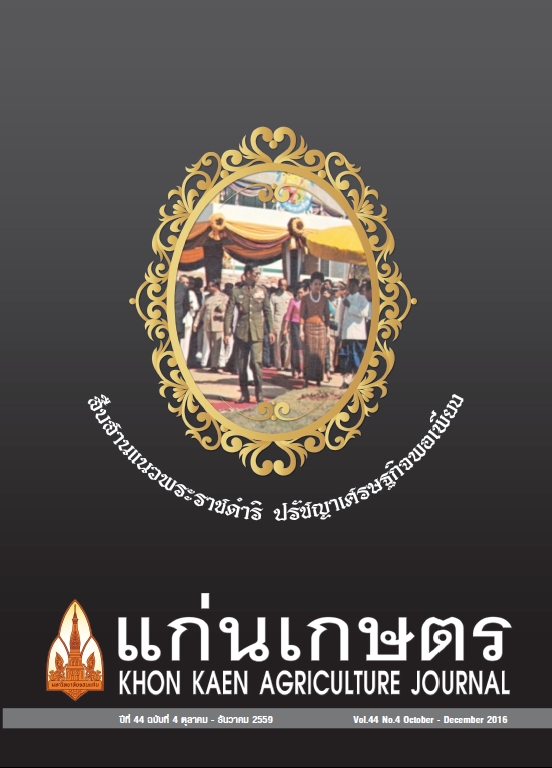Relationship of stomata and leaf color to the resistant level against rust disease of corn
Main Article Content
Abstract
Accurate, rapid and effective screening techniques for disease resistance is necessary for plant breeding aiming to increase disease resistance in crop species. The objective of this study was to evaluate the relationships among leaf stomatal characters and leaf color with rust (Puccinia polysora Underw) resistance levels in 11 accessions of corn. Corn accessions were evaluated for rust resistance in the dry season 2014/2015 at 7, 14 and 21 days after flowering (DAF). Data were also recorded for stomatal characters and leaf color at V11 growth stage. The accessions NS3 and Fancy111 had moderate to high levels of rust resistance. Disease scores for rust resistance evaluated at 7, 14 and 21 DAF were positively correlated with width of stomata at adaxial leaf surface (r=-0.77** -0.70* and-0.73**, respectively), width of stomata at abaxial leaf surface (r = -0.79** -0.76* and -0.79**, respectively) and leaf color (r = -0.59** -0.67** and -0.66**, respectively), but they were not correlated or had low correlations with number of leaf stomata and length of leaf stomata (both in adaxial and abaxial). The results suggests that width of leaf stomata on adaxial and abaxial and leaf color can be used for indirect selection of corn at preliminary stage to increase resistance to rust.
Article Details

This work is licensed under a Creative Commons Attribution-NonCommercial-NoDerivatives 4.0 International License.
References
กิ่งเพชร แก้วประเสริฐ. 2554. การพัฒนาดัชนีชี้วัดปริมาณไนโตรเจนในใบของข้าวโพด. วิทยานิพนธ์ปริญญาวิทยาศาสตรมหาบัณฑิต มหาวิทยาลัยเกษตรศาสตร์, กรุงเทพฯ.
เจตษฎา อุตรพันธ์, ทวีศักดิ์ ภู่หลำ, เฉลิมพล ภูมิไชย์ และประภา ศรีพิจิตต์. 2552. การวิเคราะห์พันธุกรรมที่ควบคุมลักษณะความต้านทานโรคราสนิมในข้าวโพด. น. 35-42. ใน: การประชุมวิชาการของมหาวิทยาลัยเกษตรศาสตร์ ครั้งที่ 47. 17-20 มีนาคม 2552. สาขาพืช คณะเกษตรศาสตร์ มหาวิทยาลัยเกษตรศาสตร์, กรุงเทพฯ.
ปณวัตร สิขัณฑกสมิต, อุณารุจ บุญประกอบ และรัติยา พงศ์พิสุทธา. 2557. การระบาดของโรคราสนิมและความต้านทานของพี้ชในประเทศไทย. แก่นเกษตร. 42(3): 668-673
มนตรี บุญจรัส. 2555. บทบาทของซิลิคอนต่อการบรรเทาความเครียดจากปัจจัยอชีวนะ. แหล่งข้อมูล: https://goo.gl/gb3zFx. ค้นเมื่อ 22 มีนาคม 2559.
สมเกียรติ ฐิตะฐาน, ดิลก อัญชลิสังกาศ, วีระ แจ่มกระจ่าง และนิยม จิ้วจิ้น. 2521. โรคข้าวโพด. เอกสารวิชาการเกษตร กระทรวงเกษตรและสหกรณ์, 22 หน้า.
สุธาทิพย์ แสงกุล. 2532. ความรุนแรงของโรคราสนิม Puccinia polysora Underw. ต่อข้าวโพดพันธุ์ต่างๆ. วิทยานิพนธ์ปริญญาวิทยาศาสตรมหาบัณฑิต (เกษตรศาสตร์), มหาวิทยาลัยเกษตรศาสตร์, กรุงเทพฯ.
สุรศักดิ์ เพิ่มลาภ. 2539. การศึกษาปากใบของพรรณไม้หอมบางชนิด.วิทยานิพนธ์ปริญญาวิทยาศาสตรมหาบัณฑิต มหาวิทยาลัยเกษตรศาสตร์, กรุงเทพฯ.
Agarwal, P. C., R. K. Khetarpal, and M. M. Payak. 2001. Polysora rust of maize caused by Puccinia polysora. Indian Journal of Agricultural Sciences. 71: 275-276.
Aghora, T. S. 1999. Studies on mechanisms of resistance to rust and genetics of quantitative haracters in snap bean (Phaseolus vulgaris L.). Ph.D. Thesis. University of Agricultural Sciences, Dharwad, India.
Auwanich, W., and D. Anchareesangas. 1998. Plant Disease and Microbiology Newsletter. 8(1): 11-14.
Camargo, R. S., L. C. Forti, R. T. Fujihara, and F. Roces. 2011. Digging effort by leaf-cutting ant queens (Atta sexdens rubropilosa) and its effects on survival and colony growth during the claustral phase. Insectes Sociaux. 58: 17-22.
Chen, C. X., Z. L. Wang, D. E. Yang, C. J. Ye, Y. B. Zhao, D. M. Jin, M. L Weng, and B. Wang. 2004. Molecular tagging and genetic mapping of the disease resistance gene RppQ to southern corn rust. Theoretical and Applied Genetics. 108: 945-950.
Deacon, J. W. 2006. Fungal Biology. Blackwell Publishing Ltd.4th Edition, Oxford, UK. 371p.
Divya, B., T. S. Aghora, A. Rekha, H. P. Sudeep, and B. N. Radha. 2014. Physiological Basis of Rust Resistance in French Bean (Phaseolus Vulgaris). International Journal of Horticulture. 4(11): 53-57
Edington, B. R., P. E. Shanahan, and F.H. J. Rijkenberg. 1994a. Breeding for partial resistance in dry beans (Phaseolus vulgaris L.) to bean rust (Uromyces appendiculatus). Annals of Applied Biology. 124: 341-350.
Groth, J. V., and N. V. Rama Raje Urs. 1982. Differences among bean cultivars in receptivity to Uromyces phaseoli var. typica. Phytopathology. 72: 374-378.
Holland, J. B., D. V. Uhr, D. Jeffers, and M. M. Goodman. 1998. Inheritance of resistance to southern corn rust in tropical-by-corn-belt maize populations,” Theoretical and Applied Genetics. 96(2): 232-241.
Ji, H. C. 2006. Epidermal cell response to rust hyphae and the resistance mode of tropical maize to southern corn rust (Puccinia polysora Underwood).Journal of Plant Biology. 49(5): 392-397.
Kalappanaver, I. K., and R. V. Hiremath. 2000. Studies on stomatal characters in foliar disease resistant and susceptible sorghum genotypes. Karnataka Journal of Agricultural Science. 13: 68-72.
Lianghua, W., and Z. Zengrong. 1994. The relationship between rice leaf color and occurrence of rice diseases and Insects and Its mechanism. Chinese Journal of Rice Science. 8(4): 231-235.
Melching, J.S. 1975. Corn rust: type, races and destructive potential, pp.90-115. In: Proceeding of the 30th Annual Corn and Sorghum Research Conference. 30 th ASTA Chicago, USA.
Meidner, H., and T. A. Mansfield.1968. Physiology of stomata.McGraw-Hi11 Book, Co., London. 179 p.
Meyer, B. S., D. B. Anderson, R. H. Bohning, and D. G. Fratianne. 1973. Introduction to plant physiology 2nd edition. D. Van Nostrand Company, New York, New York. 565 p.
Pernezny, K., and T. Kucharek. 1999. Rust diseases of several legumes and corn in Florida. Department of 281 Plant Pathology, Florida Cooperative Extension, Gainsville, FL.
Raid, R. N., S. P. Pennypacker, and R. E. Stevenson. 1988. Characterization of Puccinia polysora epidemics in Pennsylvania and Maryland. Phytopathology. 78: 579-585.
Rodrigues-Ardon, R., G. E. Scott, and J. F. Hennen. 1980. Maize yield losses caused by southern corn rust. Crop Science. 20: 812-814.
Shukla, S. N., and S. Gangopadhyaya. 1981. Stomatal index and size of stomatal opening of rice cultivars varying in reaction to bacterial leaf blight. Proceedings of the Indian National Science Academy. 4: 557-559.
Sikhandakasmita, P., U. Boonprakob, and R. Pongpisutta. 2014. Stone fruit rust epidemiology and resistance of peach in Thailand. Khon Kaen Agri. J. 42(3): 668-673.
Timothy, M. S., and W.S. Arnold. 2013. Mineral nutrition contributes to plant disease and pest resistance. Document is HS1181, one of a series of the Horticultural Sciences Department. Available: https://edis.ifas.ufl.edu/hs1181. Accessed March 14, 2016.

